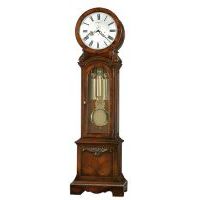Recent years have been accompanied by the incorporation of new features and technologies into mechanical grandfather clocks, mechanical mantle clocks, as well as keywound wall clocks. Some of these same, and additional features, have also been included in the quartz of battery driven versions of wall clocks, mantel clocks, and grandfather and grandmother clocks.
Not all of these added features are included on all models, and even the same general features can have distinct differences between mechanical chiming clocks and their quartz-driven battery-operated counterparts.
One of the most desired features that has been introduced on many grandfather clocks, and those clocks for the wall or mantle too, is automatic nighttime shutoff. Clocks with this feature almost always will also have a chime on-off switch as well, so one can turn the clock chime of during the day as well if so desired, on a day-to-day basis. This feature is very convenient for those that want to have the chimes during the day, but not during what would be considered the usual and customary hours for sleeping. The automatic option typically leaves no choice as to when the clocks stop chiming at night and when they start up again in the morning. It is preset, period.
It is worth noting that the chime on most all new mechanical grandfather clocks chiming and gongs counting the hours is generally a much lower volume than those from days gone by. We believe and understand that the manufacturers have done this to appeal to the largest majority of consumers. And let’s face it — today people’s attentions can be divided in any given room can be divided between a myriad of electronics including other sound making devices. People can also see the time in many more places than they used to be able to in past times. So the combination of the two has meant that the greatest mass market acceptance for chiming grandfather clocks and mechanical and chiming wall clocks and mantel clocks has been to lower the volume significantly. Still, having said that, the auto-night-shutoff-feature is a popular one, and for good reason.
Another feature on some clocks is one or more of lit dials (even backlit dials, e.g. on the Engels Model of the Howard Miller grandfather clock which in this case features a glass frosted dial).
Howard Miller Engels Grandfather Clock
by Howard Miller
Most of the lit dials are simply those with grandfather clocks with lights shining on the front of the dial, some shining through holes purposefully made in the dial, and also lights in the cabinets to also give the grandfather clocks that illuminated feeling. It is worth noting that clocks with this feature also need to be near an electrical outlet as this feature of lighting is completely independent of the movements, at least in the clocks that we sell and built to date.
Chimes innovations have also taken place on grandfather clocks, as well as wall clocks and mantle clock, in recent years. While still a minority, more and more both mechanical and quartz clocks are offering the Schubert Ave Maria and/or Beethoven Ode to Joy Chimes almost always in addition to the Westminster Chime and generally in place of the Whittingon Chime and St. Michaels Chime. These alternative chimes are highly sought after by many clock buyers. Very few of the mechanical models offer this as an alternative, but some buyers seek those specific models out for that very reason. We expect to see more and more mechanical chiming grandfather clocks offering one or more the the Ave Maria or Ode to Joy Chimes in addition to the Westminster Chime in the years to come.
Quartz or battery driven clocks have an added feature on their chiming clocks, which is that the volume is adjustable. For practical purposes, and despite what many people (including “experts”) will say, the chiming volume of a mechanical grandfather clock is for most all practical purposes NOT adjustable. Completely separately, the sound quality of a mechanical chime is superior almost always to that of a quartz clock, the reason being one is hearing the actual sound of the hammers striking the chime rods, as opposed to the recording one hears on a quartz chiming clock. This is true whether the clock in question is a grandfather clock, a grandmother clock, a mantel clock, or a wall clock.
Many times the features enhance the grandfather or wall or mantle clock, but they do not make the clock. In our view this is true for all of the features that have been added over the last century.

